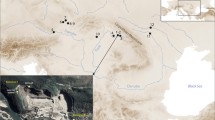Abstract
The Jebel Gharbi represents the northern border of the Tripolitanian plateau. One of its most important features is the north facing slope which opens onto the Jefara coast. Since the 1990s the Italian and Libyan Joint Mission, directed by Barbara Barich of the University of Rome “La Sapienza,” has been carrying out a project to define the cultural sequence of the region. At the beginning of the field campaign in 2000 an important settlement area was detected at the very base of the Jebel, near the village of Shakshuk. The importance of the area, which is located between the Jefara plain and the alluvial fan belt, is due to the different horizons of human occupation and to the plentiful archaeological findings scattered on the surface. Perennial water sources allowed the territory to be inhabited even in the most arid phases of the Pleistocene.
Résumé
Le Jebel Gharbi constitue la limite septentrionale du haut plateau tripolitain dont l’élément le plus significatif est son imposant escarpement qui, orienté au nord fait face à la plaine côtière de la Gefara. Depuis les années 90, la Mission Archéologique Italo–Libyenne dans le Jebel Gharbi, dirigée par Barbara Barich (Université de Rome « La Sapienza »), a entrepris un projet de recherche à long terme, destiné à l’élaboration de la séquence culturelle de la région. Pendant la campagne de fouilles 2000, une importante zone de sédentarisation, caractérisée par différents niveaux d’occupation anthropique et de nombreux matériels archéologiques a été reconnue immédiatement aux pieds du Jebel, à proximité du village actuel de Shakshuk, entre la plaine de la Gefara et les dépôts alluvionnaires. Ces réserves d’eau pérennes ont permis l’occupation du territoire même pendant les phases plus arides du Pléistocène.






Similar content being viewed by others
Notes
This terminology has been proposed by Garcea 2004 (Editors).
In this case study, chips are flakes up to 10 mm. All the unidentifiable blanks have been defined as chunks.
References
Barich, B. E. (2006). The archaeology of Jebel Gharbi—Contributions to the knowledge of the Pleistocene–Holocene transition in Northern Libya. In K. Kroeper, M. Chlodnicki, & M. Kobusievicz (Eds.), Archaeology of Early Northeastern Africa. In memory of Lech Krzyzaniak (pp. 959–969). Poznan: Poznan Archaeological Museum.
Barich, B. E., & Conati Barbaro, C. (2003). Ras el Wadi (Jebel Gharbi): New data for the study of the Epipalaeolithic tradition in Northern Libya. Origini, XXV, 75–146.
Barich, B. E., Garcea, E. A. A., & Giraudi, C. (2006). Between the Mediterranean and the Sahara: Geoarchaeological reconnaissance in the Jebel Gharbi, Libya. Antiquity, 80(309), 567–582.
Bouzouggar, A., Barton, R. N. E., & De Araujo, I. (2004–2005). A brief overview of recent research into the Aterian and Upper Palaeolithic of Northern and Eastern Morocco. In B. Barich (Ed.), Tra il Sahara e il Mediterraneo: Il Jebel Gharbi (Libia) e l’Archeologia del Maghreb. Scienze dell’ Antichità 12 (pp. 473–488). Rome: Edizioni Quasar.
Garcea, E. A. A. (2004). Crossing deserts and avoiding seas: Aterian North African-European relations. Journal of Anthropological Research, 60, 27–53.
Garcea, E. A. A., & Giraudi, C. (2006). Late Quaternary human settlement patterning in the Jebel Gharbi, Northwestern Libya. Journal of Human Evolution, 51, 411–421.
Giraudi, C. (2005). Aeolian sand in peridesert Northwestern Libya and implications for Late Pleistocene and Holocene Sahara expansions. Palaeogeography, Palaeoclimatology, Palaeoecology, 218, 161–173.
Kruseman, G. P., & Floegel, H. (1980). Hydrogeology of Jifara Plain, NW Libya. In M. Salem, & M. Pusrewil (Eds.), The geology of Libya, 2. Tripoli: El Fathea University.
McBurney, C. B. M. (1967). The Haua Fteah Cave (Cyrenaica) and the Stone Age of the South-East Mediterranean. Cambridge: Cambridge University Press.
Mutri, G. (2004). Le società dell'Epipaleolitico maghrebino. Problemi di definizione tipologica e funzionale: un caso-studio, il sito SJ-00-55 East nel Jebel Gharbi (Libia). M.A. thesis. Rome: University of Rome “La Sapienza”.
Acknowledgments
This study was carried out within the context of the Italian–Libyan Joint Archaeological Mission in the Jebel Gharbi, co-directed by Barbara E. Barich (University of Rome “La Sapienza”) and Elena A.A. Garcea (University of Cassino). The Mission is financed by grants from the University of Rome “La Sapienza”, the Ministry of Foreign Affairs and the Ministry of Scientific Research. We are glad to acknowledge the participation in the scientific team of Mansour Mohamed Mansour and Mohamed Ali Kour, representatives of the Libyan Antiquities Department. We would also like to thank the President of the Libyan Antiquities, Giuma el Anag, as well as the Controller of the Sabratha Department, Mabrouk Zinati, and the Governmental Authorities of the Jebel Gharbi for their kind hospitality and support during our work.
Author information
Authors and Affiliations
Corresponding author
Rights and permissions
About this article
Cite this article
Mutri, G., Lucarini, G. New Data on the Late Pleistocene of the Shakshuk Area, Jebel Gharbi , Libya. Afr Archaeol Rev 25, 99–107 (2008). https://doi.org/10.1007/s10437-008-9026-0
Published:
Issue Date:
DOI: https://doi.org/10.1007/s10437-008-9026-0




